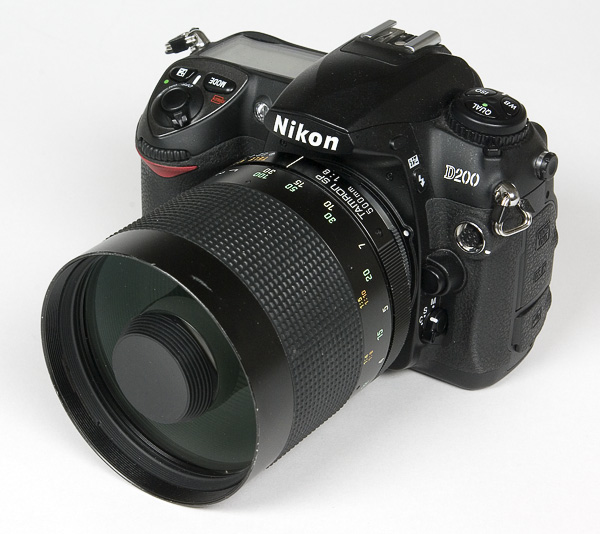|
Tamron 500mm f/8 SP macro (Adaptall-to-Nikon) Review / Test Report |
|
Lens Reviews -
Nikon / Nikkor (APS-C)
|
|
Page 1 of 3
Review by Klaus Schroiff, published July 2007
Lens kindly provided for testing purposes by Dr. Thomas Rubach!
Introduction
The Tamron 500mm f/8 SP BBAR MC macro is the first mirror lens that found its way to
the testing lab. Mirror lenses are rather strange beings. They combine both
heaven and hell ... heaven because they offer an extreme reach, compact size &
low weight and all that for an affordable price tag - hell because they
have no variable aperture, (usually) no AF, they're slow and their
bokeh (out-of-focus blur) looks very odd. That's enough to give users a
serious headache and consequently they're not overly popular these days.
In fact the Sony AF 500mm f/8 is the only mirror lens from a primary manufacturer
that is still in production (and it is the only AF mirror lens out there).
Naturally you can still find lots of mirror lenses on the used market like
the "Russian ton" (MC Rubinar 1000 f/10), the Tokina 500mm f/8 RC and this
Tamron 500mm f/8 BBAR.

As mentioned mirror lenses are extremely compact relative to their long focal
length. This is achieved by "folding" the optical path using two mirrors -
here's a simplified schema of a mirror lens:

From a photographic point of view this approach has advantages and disadvantage.
As you may notice there aren't many glass elements involved here. Consequently
mirror lenses do not suffer from a significant amount of chromatic aberrations
(color shadows at the image borders).
On the downside the mirrors eat quite a bit of contrast which is why many mirror
lenses have a reputation to produce dull images. The secondary mirror sitting
in the middle of the light path causes two more effects - it reduces the amount
of light that can enter the lens (which costs about one f-stop) and it "punches
a hole" into the aperture shape which is responsible for the dreaded donut-like
effect on out-of-focus highlights (see the bokeh chapter).

The build quality of the Tamron is very good. The lens is mostly made of metal
and the very broad, rubberized focus ring operates very smooth and very well
damped. The Tamron 500mm f/8 has an "adaptall" mount - this is a proprietary
mount system by Tamron. Using dedicated adapters you can mount these
adaptall lenses to virtually any system out there. However, typical for such
adapter solutions there's no electronic coupling. This is not a big deal
when it comes to the Nikon Ai-S adapter because the lens simply behaves
like a manual focus Nikkor lens and the Tamron has no aperture mechanism nor
AF anyway so there isn't too much to set anyway. Used on the Nikon D200 the focus
confirmation in the viewfinder remains active giving you a bit of a focus
guidance. The D200 had quite some troubles to provide a proper white balance
with this lens (probably another side-effect of the mirror design) so you better
set the WB manually.
| Specifications |
|---|
| Equiv. focal length | 750 mm (full format equivalent) |
| Equiv. aperture | f/12 (full format equivalent, in terms of depth-of-field) |
| Optical construction | 7 elements in 4 groups |
| Number of aperture blades | - |
| min. focus distance | 1.7 m (max. magnification ratio 1:3) |
| Dimensions | 84 x 92 mm |
| Weight | 595 g |
| Filter size | 82 mm (non-rotating) |
| Hood | - |
| Other features | Adaptall II system (generic mount) |
|